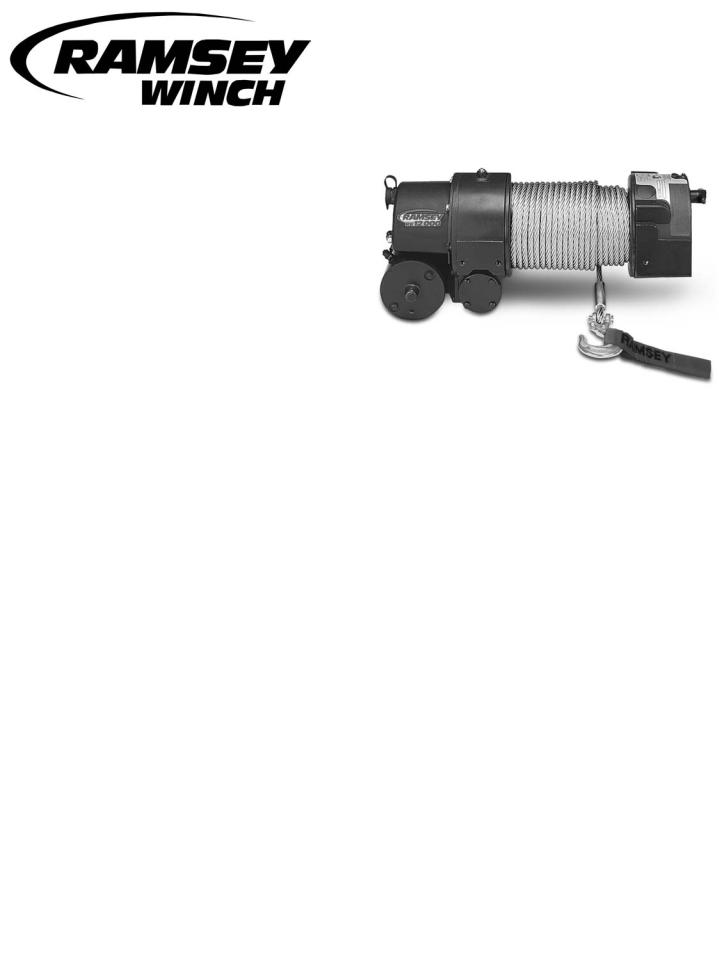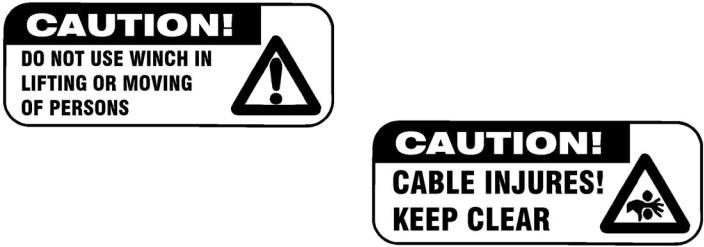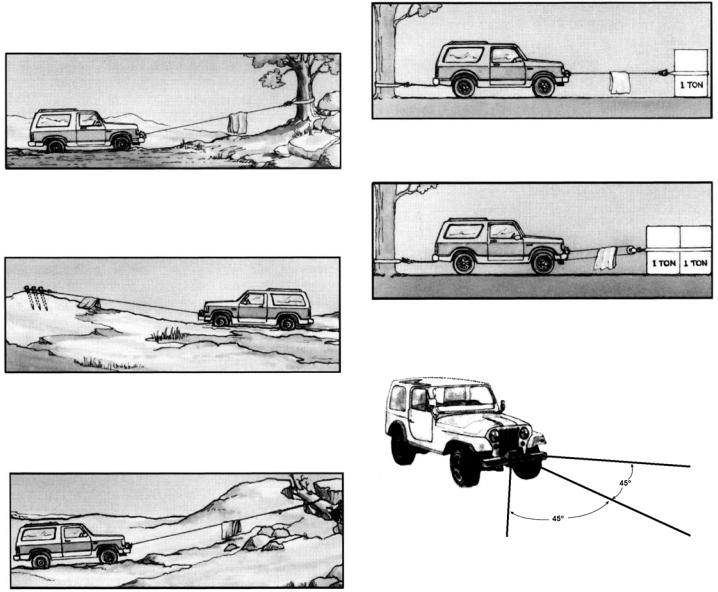Ramsey RE-12000 User Manual

Ramsey Winch Company
OWNER’S MANUAL
Front Mount Electric Winch
RE 12000
Special for Military H-1 Hummvee
|
Layer of Cable |
|
1 |
2 |
3 |
4 |
|
|
|
|
|
|
|
|
|
|
|
|
|
|
Rated Line Pull Per Layer |
(lbs) |
12,000 |
10,000 |
8,600 |
7,500 |
|
|
|
|
|
(kg) |
5,450 |
4,540 |
3,900 |
3,400 |
|
|
|
|
Cumulative Cable |
(ft)* |
20 |
40 |
70 |
100 |
|
|
|
|
|
|
|
|
|||||
|
Capacity Per Layer |
|
|
|
|
|
|
|
|
|
(3/8" - 9mm - dia. Cable) |
(m)* |
6 |
12 |
21 |
30 |
|
|
|
|
|
|
|
|
|
|
|
|
|
|
|
|
|
|
|
|
|
|
|
|
Line Pull First Layer |
(lbs) |
NO |
2,000 |
4,000 |
6,000 |
8,000 |
10,000 |
12,000 |
|
(kg) |
LOAD |
900 |
1,810 |
2,720 |
3,630 |
4,540 |
5,450 |
|
|
|
||||||||
|
Line Speed First Layer |
(FPM) |
14 |
7 |
5 |
4 |
3.5 |
2.5 |
2 |
|
|
(MPM) |
4.2 |
2.1 |
1.5 |
1.2 |
1 |
0.7 |
0.6 |
|
Amp Draw |
24V |
30 |
50 |
85 |
110 |
135 |
160 |
190 |
* Depends on cable being uniformly wound onto drum.
Congratulations
You have purchased the finest winch available in its service class. It features a strong worm and gear drive to provide load reversing protection. An exclusive semi-automatic RAM-LOKTM clutch disengaes for free-spooling and is spring loaded for positive engagement. It was designed and manufactured to provide you with the utmost in utility. As with any device that combines power and movement in its use, there are dangers if improperly used. At the same time, there are easier and faster was for getting the job done if certain precautions are taken first.
Please read this manual carefully. It contains useful ideas in obtaining the most efficient operations from your Ramsey Winch and safety procedures you need to know before beginning use. When you follow our guidelines for operation, your Ramsey Winch will give you many years of satisfying service. Thank you for choosing Ramsey. You will be glad you have one working for you.
Contents
Safety Precautions . . . . . . . . . . . . . . . . . . . . . . . . . . . . . .2 Tips for Safe Operation . . . . . . . . . . . . . . . . . . . . . . . . . . .2 Techniques of Operation . . . . . . . . . . . . . . . . . . . . . . . . . .3 Installation . . . . . . . . . . . . . . . . . . . . . . . . . . . . . . . . . . . .4 Electrical Connections and Operations . . . . . . . . . . . . . . .4 Cable Installation . . . . . . . . . . . . . . . . . . . . . . . . . . . . . . .4 Operating Instructions . . . . . . . . . . . . . . . . . . . . . . . . . . . .4 Maintenance . . . . . . . . . . . . . . . . . . . . . . . . . . . . . . . . .4-5 Troubleshooting . . . . . . . . . . . . . . . . . . . . . . . . . . . . . . . .5 Winch Parts List . . . . . . . . . . . . . . . . . . . . . . . . . . . . . .6-7 Test Procedures . . . . . . . . . . . . . . . . . . . . . . . . . . . . . . .8-9 Warranty . . . . . . . . . . . . . . . . . . . . . . . . . . . . . .Back Cover Please Note: Ramsey RE 12000 Series winches are designed for front mount vehicle use. It is not designed for and should not be used in industrial applications (car haulers/carriers, wreckers, hoisting, etc.) and Ramsey does not warrant them to be suitable for such use. Ramsey makes a separate, complete line of winches for industrial/commercial use. Please contact the factory for further information.
CAUTION: Read and understand this manual before installation and operation of winch. See precautions.

Safety Precautions To Guard Against Possible Injury…
A minimum of five wraps of cable around the drum barrel is necessary to hold the rated load. Cable clamp is not designed to hold the load.
A.Keep yourself and others a safe distance to the side of the cable when pulling under load.
B.Don't step over a cable, or near a cable under load.
C.Use supplied hook strap when handling hook for spooling wire rope.
D.Don't move the vehicle to pull a load on the winch cable. This could result in cable breakage.
E.Use a heavy rag or gloves to protect hands from burrs when handling winch cable.
F.Apply blocks to wheels when vehicle is on an incline.
G.Winch clutch should be disengaged when winch is not in use and fully engaged when in use.
H.Modification, alteration, or deviation to the winch should only be made by Ramsey Winch Company.
I.Keep the duration of your pulls as short as possible. If the motor becomes uncomfortably hot to the touch, stop and let it cool for a few minutes. Do not pull more than two minutes at or near rated load. Do not maintain power to the winch if the motor stalls. Electric winches are for intermittent usage and should not be used in constant duty applications.
J.Disconnect the remote control switch from the winch when not in use. A Ramsey Part # 282053 safety on-off switch in your vehicle is recommended.
K.Note: Do not use winch in hoisting applications due to required hoist safety factors and features.
L.Do not exceed maximum line pull ratings shown in tables.
M.To respool correctly, it is necessary to keep a slight load on the cable. This is accomplished by (wearing gloves) holding the cable with one hand and the remote control switch with the other, starting as far back and in the center as you can, walking up keeping load on the cable as the winch is powered in. Do not allow the cable to slip
through your hand and do not approach the winch too closely. Turn off the winch and repeat the procedure until all the cable except a few feet is in. Disconnect the remote control switch and finish spooling in cable by rotating the drum by hand with clutch disengaged. On hidden winches, spool in cable under power but keep hands clear.
Tips for Safe Operation
Do not underestimate the potential danger in winching operations. Neither should you fear them. Do learn the basic dangers and avoid them.
The uneven spooling of cable, while pulling a load, is not a problem, unless there is a cable pileup on one end of drum. If this happens, reverse the winch to relieve the load and move your anchor point further to the center of the vehicle. After the job is done you can unspool and rewind for a neat lay of the cable.
Store the remote control switch inside your vehicle where it will not become damaged. Inspect it before you plug it in. When ready to begin spooling in, plug in remote control switch with clutch disengaged. Do not engage clutch with motor running.
Never connect the hook back to the cable. This causes cable damage. Always use a sling or chain of suitable strength as shown in the illustration.
Observe your winch while winching, if possible, while standing at a safe distance. If you use vehicle drive to assist, stop and get out every few feet to assure the cable is not piling up in one corner. Jamming cable can break your winch.
Do not attach tow hooks to winch mounting apparatus. They must attach to vehicle frame.
When double lining during stationary winching, the winch hook should be attached to the chassis of the vehicle.
Since the greatest pulling power is achieved on the innermost layer of your winch, it is desirable to pull off as much line as you can for heavy pulls (remember, you must leave 5 wraps minimum on the drum). If this is not practical, use a snatch block and double line arrangement (see illustration).
Neat, tight spooling avoids cable binding, which is caused when a load is applied and the cable is pinched between two others. If this happens, alternately power the winch in and out a few inches. Do not attempt to work a bound cable under load, free by hand.
2

Techniques of Operation
The best way to get acquainted with how your winch operates is to make a few test runs before you actually need to use it. Plan your test in advance. Remember you hear your winch as well as see it operate. Get to recognize the sound of a light steady pull, a heavy pull, and sounds caused by load jerking or shifting. Soon you will gain confidence in operating your winch and its use will become second nature with you.
When pulling a heavy load, place a blanket, jacket or tarpaulin over the cable five or six feet from the hook. It will slow the snap back in the event of a broken cable. Also open the vehicle hood for additional protection.
For basic self-recovery, anchor to a tree or heavy rock. When anchoring to a tree, always use a tree trunk protector.
Stakes driven in solid earth and chained together make a good anchor point for self-recovery when no solid anchor point is available.
For a solid anchor, bury a log with earth or sand or place it in a deep ravine.
Use the vehicle wheel power to help the winch, but do not overtake the winch line. Plan your pull. You cannot always hook up and pull out in one step. Examine all the areas for anchoring possibilities as well as leverage situations, direction, and goal.
Your winch will not only pull you up or ease you down a steep grade, it will also pull another vehicle or a load while your vehicle is anchored in a stationary position. The following sketches show you a few techniques.
For direct pull of 2,000 lbs, hitch truck to a tree or solid anchor, and take out of gear.
To double the pull, use 2-part line with snatch block and tie off to chassis. Take out of gear.
Winches equipped with cable guide fairleads can pull from several directions. Pull from an angle only to straighten up the vehicle-otherwise you can damage structural members or other parts of your vehicle and cause excess cable buildup on one end of the winch drum.
3
Installation
This winch is designed to be used exclusively in the Ramsey Military H-1 Hummvee mounting kit. Install the winch in the H-1 Hummvee Mounting Kit P/N 295376 according to the instructions supplied with the mounting kit.
Substitution of attaching hardware items (bolts, nuts, or washers) different from those supplied with your winch mounting kit can lead to failure causing damage or serious injury. Use SAE Grade 5 bolts or better.
Electrical Connections and Operations
For normal self recovery work, your existing electrical system is adequate. For power requirements for this winch, refer to the table on page one of this manual. Your battery must be kept in good condition. A fully charged battery and proper connections are essential. Run the vehicle engine during the winching operation to keep the battery charged.
Connect the battery cables according to the instructions with the mounting kit. A good electrical ground is required for proper performance.
The remote control switch is water-proof and has push button stations on either side. It is designed this way to prevent quick winch reversals which lead to solenoid failure. Make the winch motor has stopped fully before reversing.
When first setting up your winch, follow the directions for inserting the proper “IN” or “OUT” labels in the thumb button. The switch is also color coded to aid you in not having to guess at the direction your winch will run.
Cable Installation
1.Unwind cable by rolling it out along the ground to prevent kinking. Securely wrap the end of the cable, opposite hook, with plastic or similar tape to prevent fraying.
2.Insert the end of the cable, opposite hook end, under drum and into the 7/16” dia. hole in drum barrel. Secure cable to drum barrel, using setscrew furnished with winch. Tighten setscrew securely.
3.Carefully run winch in the “reel-in” direction. Keeping tension on end of cable, spool all the cable onto the drum, taking care to form neatly wrapped layers.
Inspect the cable frequently. If the cable becomes frayed with broken strands, replace immediately. Cable and hook assemblies may be purchased from a Ramsey distributor.
Operating Instructions
The RAM-LOKTM semi-automatic clutch provides free spooling and clutch engagement with the cable drum. With the clutch disengaged, the cable can be pulled off the drum by hand. For winching in the load, the clutch must be fully engaged with the drum.
To disengage the clutch, run the winch in the reverse “reel out” direction until the load is off the cable and the cable drum stops turning. Rotate the clutch handle 90° clockwise. The clutch is now locked out and the cable may be pulled by hand. (NOTE: If the handle will not rotate, run the winch momentarily in reverse to relieve pressure on the clutch jaws.) WARNING: DO NOT
ATTEMPT TO DISENGAGE THE CABLE DRUM WHEN THERE IS A LOAD ON THE CABLE.
To engage the clutch, rotate the handle 90° counterclockwise. Run the winch in reverse until the cable drum starts turning. To confirm that the clutch is fully engaged, remove the plastic plug in the top of the clutch housing to inspect the clutch. After the winch is fully engaged, the winch is ready for winching in the cable.
Maintenance
Check monthly the action of the clutch, making sure it is fully engaging and disengaging with the cable drum. With the clutch in the engaged position, remove the plastic plug in the top of the clutch housing and observe if the clutch is engaging. If the clutch is not fully engaging, inspect the clutch shifter assembly parts. Check for damage or excessive wear and replace as necessary. Observe the jaws on both the clutch and cable drum, checking for rounding of the driving faces. If rounding has occurred they should be replaced immediately.
4
